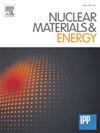线基激光金属镀层等离子表面元件的高热流密度测试
IF 2.7
2区 物理与天体物理
Q1 NUCLEAR SCIENCE & TECHNOLOGY
引用次数: 0
摘要
未来核聚变电站的等离子体面组件(pfc)所处的恶劣环境和载荷将不可避免地导致其装甲的侵蚀。材料局部沉积原位再生将为侵蚀材料的损伤愈合和补偿提供可能。线基激光金属沉积(LMD-w)工艺满足了在反应堆容器中使用的必要要求。在W衬底上沉积W的工艺开发已经进行,并且已经证明这种方法可以修复PFM中的热损伤。在这项研究中,使用LMD-w涂层W装甲pfc,并在电子束设施JUDITH 2中进行融合相关热负荷测试。两层堆叠层,每层高度约0.65 mm,分别应用于W双瓦的顶部表面,其表面积分别为28 × 12 mm2,这是单体体面向等离子体表面的特征尺寸。一些涂层表面也被激光重熔光滑。在电子束设施JUDITH 2中,测试组件暴露于稳态以及稳态和瞬态热负荷的组合,这些负荷预计将在未来示范电厂的导流区使用。涂层在循环(200和1000循环)稳态热负荷下进行测试,其表面温度相当于10 MW m - 2(~ 1000°C)和15 MW m - 2(~ 1500°C)的单块组件的热流。为了确定LMD-w层在边缘局域模式(elm)下的热负荷下的性能,一些层经受了稳态和瞬态载荷的组合(0.13-0.55 GW m−2,103 - 105脉冲,0.48 ms, 200-700°C基温)。对HHF实验得到的温度数据进行了处理和分析。采用高热流密度(HHF)暴露前后涂层表面的剖面测量方法,研究了热应力对镀层的影响。此外,制备并分析了被试组分的截面显微图。本文章由计算机程序翻译,如有差异,请以英文原文为准。
High heat flux testing of wire-based laser metal deposition coated plasma-facing components
The severe environment and loads acting on plasma-facing components (PFCs) of future fusion power plants cause inevitable erosion of their armor. In situ regeneration of tungsten (W) armored PFCs by local deposition of material would open up the possibility of damage healing and compensation of eroded material. The wire-based laser metal deposition (LMD-w) process fulfils the necessary requirements for use in the reactor vessel. Process development for the deposition of W on W substrate has already been carried out and it has been proven that thermal induced damage in the PFM can be healed this way. In this study, W armored PFCs were coated using LMD-w and tested under fusion–relevant thermal loads in the electron beam facility JUDITH 2. One respectively two stacked layers, each ∼0.65 mm in height, were applied on the top surfaces of the W double tiles with surface areas of 28 × 12 mm2 respectively, which are the characteristic dimensions for the plasma-facing surface of monoblocks. Some of the coated surfaces were also smoothed by laser remelting. In the electron beam facility JUDITH 2, the test components were exposed to steady state as well as combined steady state and transient thermal loads that are expected in the divertor area of the future DEMOnstration power plant. The coatings were tested with cyclic (200 and 1000 cycles) steady state thermal loading in the form of surface temperatures equivalent to heat fluxes on monoblock components of 10 MW m−2 (∼1000 °C) and 15 MW m−2 (∼1500 °C). To determine the performance of LMD-w layers under thermal loads that are expected during exposure to edged localized modes (ELMs), some layers were subjected to combined steady state and transient loading scenarios (0.13–0.55 GW m−2, 103 to 105 pulses of 0.48 ms, 200–700 °C base-temperature). The temperature data obtained from the HHF experiments was processed and analyzed. Profile measurements on the coated surfaces before and after the high heat flux (HHF) exposure were used to investigate the influence of thermal stress on the deposited layers. Furthermore, cross-sectional micrographs of the test components were prepared and analyzed.
求助全文
通过发布文献求助,成功后即可免费获取论文全文。
去求助
来源期刊

Nuclear Materials and Energy
Materials Science-Materials Science (miscellaneous)
CiteScore
3.70
自引率
15.40%
发文量
175
审稿时长
20 weeks
期刊介绍:
The open-access journal Nuclear Materials and Energy is devoted to the growing field of research for material application in the production of nuclear energy. Nuclear Materials and Energy publishes original research articles of up to 6 pages in length.
 求助内容:
求助内容: 应助结果提醒方式:
应助结果提醒方式:


